
President Erdogan
Since I last wrote about Turkey in an earlier blog, on Friday, July 15, a failed military coup tried to take over the country. It was not well organized and the coup was quickly put down. Elected to office three times, President Recep Tayyip Erdoğan is popular with his constituents as shown when he went on social media and called for citizens to take to the streets to stop militia involved in the coup. The failed coup, however, has had major repercussions for those considered disloyal to Erdogan.
Since the coup, the government has rounded up thousands of suspected military and judiciary officials including generals and other high-ranking officers. This week, Erdogan cracked down on numerous educators and media outlets, an upsetting turn for people who view these actions as extreme. Some feel Erdogan is taking the coup as an opportunity to purge those viewed as disloyal to the government.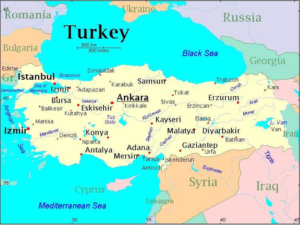
With all that has happened, Turkey may appear to be just another unstable country in the powder keg area known as the Middle East. At the same time, it is important to note, since 1925 Turkey has had a secular government. While Erdogan’s government has a record of tight controls over the media, Turkey has had strong political parties. Also, Turkey has a thriving middle class blending Eastern and Western cultures just as the Bosphorus blends the European and Asian sides of Istanbul.
As I wrote in my earlier blog on Turkey, we visited the country in May 2011. The Arab Spring had begun in the Middle East in 2010 with positive, social media buzz and high hopes for greater democracy throughout the region. Al Qaeda’s role had been reduced in Iraq and Afghanistan and we had not yet learned of the terrorist group known as the Islamic State.
When we visited, we had no idea of the tragic events about to explode in that part of the Middle East. Two significant events occurred while we were in Turkey: the U.S. took out Osama bin Laden and civil war in neighboring Syria was heating up.

Iman prayed in our honor*
When we awoke on May 2, 2011, we found out bin Laden had been killed at his Pakistani compound by U.S. Navy Seals. I was concerned about the reaction Turks would have to us as Americans. When I asked our guide, Ersin, about this, he said people feared bin Laden and wanted the terrorist dead. That afternoon, while visiting a small mosque, Ersin introduced us to the Iman who asked if he could recite a prayer of peace in our honor. As the Iman’s tenor voice soared through the mosque we stood with tears in our eyes.
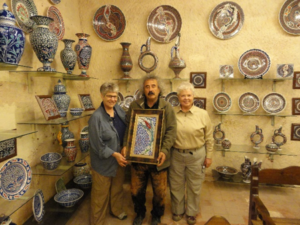
We took photo with master ceramicist, Galip and our new single-fired piece of colorful tulips.
Less dramatic, was a visit to a ceramic shop in Cappadocia owned by Galip, a master ceramicist. Galip sat at his potter’s wheel with a lump of clay and as we watched, molded it into a delicate tea pot. We then toured his shop and saw how his staff hand painted pottery pieces. We couldn’t resist. We took home one of Galip’s beautiful art pieces, a single-fired, double-sized tile decorated with multiple small blue tulips and one large red tulip.
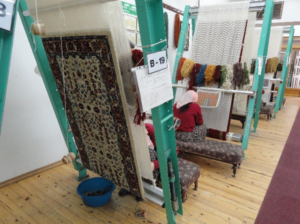
Women at looms weaving rugs
Another interesting stop was at a rug factory where we saw young women at looms weaving beautiful rugs. After being trained in the art of rug weaving, these women can go home to continue weaving and selling hand-made rugs. We also toured the rug factory and saw how silk worm cocoons are spun into thread, then dipped into colorful dyes and dried before being used to make colorful rugs.
One of our most fascinating experiences in Turkey was seeing the Whirling Dervishes perform their religious dance honoring God.

The Whirling Dervishes
It is performed by men wearing long white skirts and tall colorful hats. First, musicians begin playing slow, somber tones as the Dervishes start whirling slowly in a circle with their arms wide open. As the music grows faster and more enthusiastic, the whirling increases with the men dancing trance-like and turning ever faster with right hands reaching toward the sky and left turned down to the earth.
This ancient ritual dates back to the 13th century when a Persian poet, Rumi, founded the Mevlevi Order of Dervishes. It was practiced continually until 1925 when Turkey’s new Republic banned the order as it worked to secularize the nation.
The ban was partially lifted in 1953 and the Dervishes now are allowed to perform their ritualist dance. We saw the Dervishes perform in Konya at the Saruhan Caravanserai, meaning caravan palaces. Constructed in 1249, the building was a popular stop on the Silk Road and has been restored as the Mevlana Museum.
Our next stop was two-nights in Antalya, a coastal Mediterranean resort town. With time off in this lovely walking city, our group was happy not to have formal tours scheduled. We were all operating on information overload. We’d had full days touring Istanbul, three busy days in Cappadocia and an overnight stay at the home of a conservative Sunni family on our drive to the coast. We were ready to slow down, poke in and out of shops, have lazy lunches and delicious dinners and relax pool side at our hotel.
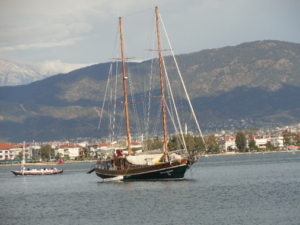
Sailing on two-masted wooden gulet up the coast
While in Turkey, we toured by plane, bus, van, taxi, ship and powerboat. We decided not to take the hot air balloon tour over the fairy chimneys of Cappadocia. Too expensive.
We set sail from the port in Antalya on a beautiful gulet, a two-masted wooden sailing vessel. For three days we sailed up the Mediterranean coast to the Aegean Sea in a beautiful mahogany schooner. The gulet had eight staterooms and the captain’s quarters to house a three-man crew, our group of twelve and Ersin. It meant the crew had to bunk in the galley.
Our first port of call was Dalyan, a coastal town that includes a famous breeding ground, Iztuzu Beach, for the internationally endangered loggerhead sea turtles. A guide took us by powerboat to the beach and we learned more about what is being done to protect the turtles.
The guide then took us up the River Dalyan to see the Lycian tombs carved in the river’s sheer cliffs.
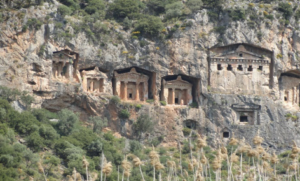
Lycian tombs carved in cliffs circa 400 BC
The weathered façades were cut from rock dating back to 400 BC. The ancient Lycians believed the dead were carried to the afterlife by magical-winged creatures. The Lycians carved tombs in the cliff’s face to place their honored dead in geographically high places and assist them on their journey.
That evening we dropped anchor in clear blue water known as Cleopatra’s Bath Cove containing Roman ruins supposedly used by Cleopatra in an area given to her as a wedding gift by Marc Anthony.
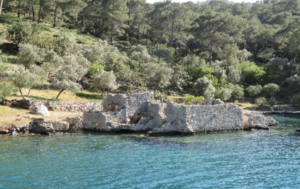
Cleopatra’s Bath
I’ve read her bath was warmed with hot water drawn from a nearby crater lake. So with the bay’s interesting background, we couldn’t resist taking a quick swim even though the water was quite cold.
Our gulet sail ended at a resort town, the Port of Kuşadası, on Turkey’s Aegean coast. From there we took a van for the one hour drive inland to Ephesus, an important port city in days of old, reported to have had a population in the hundreds of thousands.

Massive Amphitheater in Ephesus
Entering Ephesus, we saw terra cotta pipes of varying sizes carefully stacked on the ground. We learned the pipes were part of the Roman aqueducts used to bring fresh water to the city. Our first stop in the ancient city was at the amphitheater built in the first century AD. With a one-time capacity of 25,000, we imagined events and performances staged there so many centuries ago and still used today in a festival held each May.
We walked the ancient cobble stone pathways and marble roadways of this Greco-Roman ruin. We stopped by the two agoras or public squares: one for commerce and the other for official business. Ephesus is one of the world’s best-preserved sites and continues as an active archeological site.
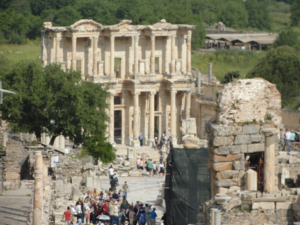
Library of Celsus’ restored façade
One of the best known buildings in Ephesus is the Library of Celsus, an ancient Roman building completed in 135 AD honoring a Roman Senator, Tiberius Julius Celsus Polemaeanus. Built by Celsus’ son, the library stored 12,000 scrolls and served as Celsus’ mausoleum with his burial in a crypt beneath the library.
An earthquake in 262 AD destroyed the library’s interior with only the library’s outer façade left standing. It, too, was destroyed by an earthquake in the tenth or eleventh century AD. The library remained in ruins until the 1970s when archaeologists re-erected the outer façade shown in photo.
As I conclude this blog, I think back on our trip to Turkey with its well-preserved past dating back 12,000 years in a land formerly known as Asia Minor. It was interesting and awe-inspiring to bear witness to this ancient past. It is unfortunate people no longer feel safe to visit this exciting and enjoyable country. Also, after visiting neighboring Turkey, it makes me both angry and sad to know ISIS has intentionally destroyed so many of ancient Persia’s historical sites, today known as Syria.
*Photos by Phyllis Bonfield
The Takeaway: Our tour of Turkey had everything. We saw beautiful structures that amazed in Istanbul and magical sites in Cappadocia. We experienced man’s kind humanity when an Iman said a prayer of peace in our honor and we had exciting adventures sailing on a gulet. We experienced man’s ingenuity in Ephesus and its highly-developed civilization thousands of years old. What interesting experiences have you had while traveling in foreign lands that may be pertinent to events occurring today? Share and let’s learn from each other. Include your name and email address or phone number so I may contact you if I have a question. I will not publish your name. Contact me at [email protected]
